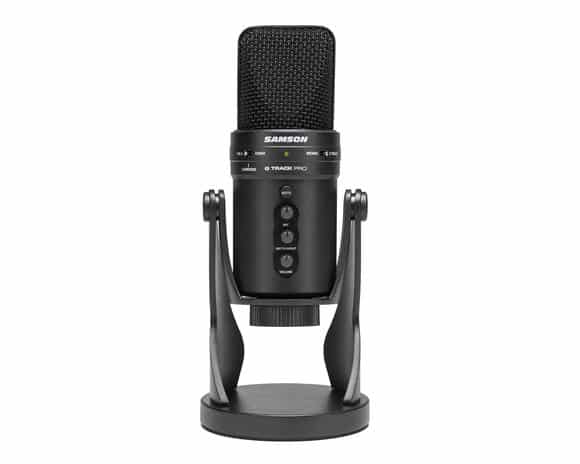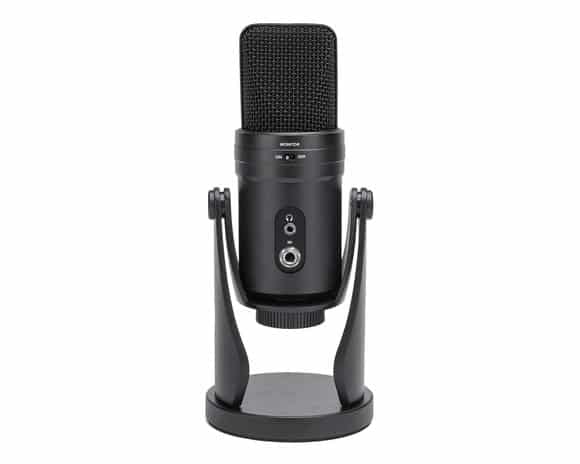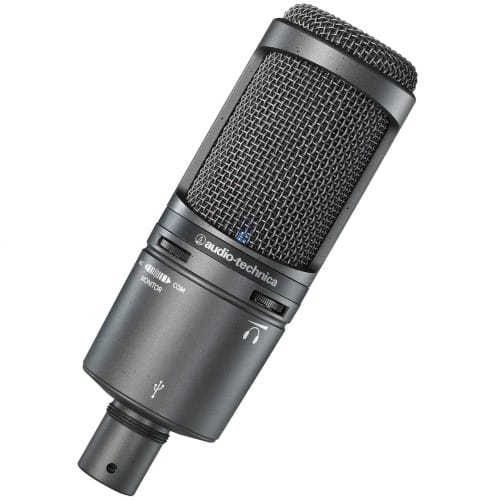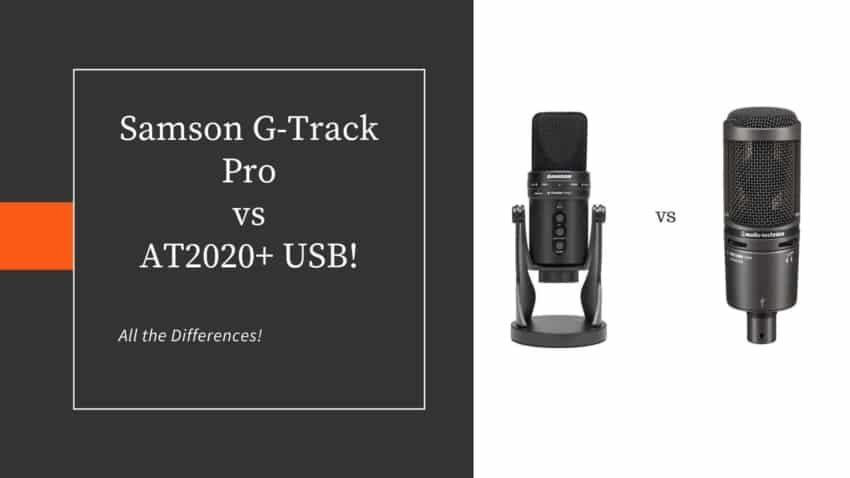Last updated on December 30th, 2023 at 02:48 pm
Are you wondering which USB microphone to purchase?
I know it can be tough to find the right one since there are dozens, if not hundreds of microphones out there.
In this post I will compare the Samson G-Track Pro to the Audio-Technica AT2020+, two of the best-known USB microphones in the industry, and I will give you honest opinion on which one you should go for.
Here are the basic differences and then I will give you a detailed description of each of them;
Differences
The Samson G-Track Pro features Cardioid, Omni- and Bi-directional polar patterns, it has a frequency response of 50Hz to 20kHz, and it comes with a built-in audio interface that lets you record the microphone and the instrument inputs to separate tracks in your DAW.
The AT2020+, on the other hand, only has a cardioid polar pattern and features a frequency response of 20Hz to 20kHz.
Samson G Track Pro

This microphone has been released fairly recently, and therefore is a bit different than all the other USB microphones out there.
The main feature that sets the Samson G Track Pro apart from all other USB microphones is its built-in interface that lets you record the vocals to one audio track as well as a guitar or bass guitar through the instrument input on the back to another track.
You can also decide to record both of them blended on to a single track as well.
More on this in a bit!
Now, let’s take a quick look at the build quality:
This microphone has probably the best build quality I’ve seen so far of any USB mic, especially if you consider the price; it’s all metal and very heavy, plus the mic desk stand -which already comes installed on the mic- is very heavy, meaning that it won’t slide around the desk easily.
One con about the mic desk stand is that it doesn’t have any padding on the bottom, and this just means that if you bump against the desk, those vibrations will be picked up by the microphone and make their way into the recording.
Other than that, the build quality is simply excellent.
One of the reasons that this microphone is so popular is because of its versatility, since it features three different polar patters; Cardioid, Omni-Directional and Bi-Directional (or figure 8).

In addition to this, it comes with a built-in audio interface that lets you record the mic input as well as the instrument input simultaneously to different tracks.
You can also choose whether you want both tracks to be blended and recorded to just one track on your DAW, or if you want to multi-track them (separate tracks).
This is achieved via the “Mono or 2 Track” switch on the front; Mono will record each track individually and you will have to select “Input 1” in your DAW to record the microphone, and “Input 2” on another track to record the instrument input.
Selecting the 2 Track configuration will blend both signals into one track, but I wouldn’t recommend this since it leaves little to no room for processing, etc.
Also, the preamps sound very nice and don’t introduce any noise whatsoever.
The two issues I found with this microphone are; it doesn’t reject background noise all that well, and the Omni-directional and Bi-directional polar patterns lose a bit of quality in terms of frequency response.
However, 90% of the time you will be using the cardioid pattern anyway, so no worries there.
Lastly, on the back it comes with a headphone output that can be used for zero-latency monitoring which really comes in handy while recording.
How does it Perform?
For any voice-related applications, I think that it just sounds fantastic since it doesn’t color the sound all that much; It does have a slight boost in the upper frequencies, but almost all microphones have that slight boost in order the help the vocals better sit in the mix.
As far as mic’ing up guitar cabinets, it actually performs a lot better than expected, and even when recording acoustic guitar, it also did a more than decent job.
However, for recording acoustic guitar I prefer the Blue Yeti… (You can red my comparison of the Blue Yeti and the Samson G-Track Pro here).
Additionally, this microphone is plug and play both on Windows 10 and MacOS, meaning that no drivers are needed; simply connect it and it works.
Lastly, since it works as a regular audio interface, you can use it with amp simulation software on the instrument track, and my concern here was latency, but it definitely wasn’t bad at all!
So, overall, it’s a pretty versatile microphone that is insanely well built and that also sounds surprisingly well!
What do you get in the Box?
- Samson G-Track Pro Microphone.
- Desk Stand.
- Microphone Mount.
- USB Cable.
- MOTU Software Download Card.
Features
- Multi-Pattern microphone; Cardioid, Omni, Figure 8.
- Excellent built quality.
- Built-in Audio Interface (two simultaneous tracks).
- Instrument Input.
- Mute Control.
- Free MOTU software downloads.
Specifications
- Polar Pattern: Cardioid (unidirectional), bidirectional, omnidirectional
- Frequency Response: 50Hz–20kHz
- Sensitivity: +6dB FS/PA (all polar patterns)
- Max. SPL: 120dB SPL
- Bit Depth: 16 or 24-bit
- Sample Rate: Up to 96kHz
- Digital Output: USB
- Headphone Output: 1/8″ (3.5mm)
- Instrument Input: 1/4″
Find out more about the Samson G-Track Pro here:
- Samson G-Track Pro: Amazon, Sweetwater.
Audio-Technica AT2020+ USB

There are few better-known brands in the music industry than Audio-Technica.
They make some of the best microphones on the market and the AT2020 is the go-to mic for almost every beginner home recording enthusiast, plus you won’t see a studio that doesn’t have at least a couple of them.
The USB version of the Audio-Technica AT2020 is just as good as the XLR AT2020 with the advantage of being a plug n’ play microphone that works both on Windows and Mac OS without the need of installing any sort of driver.
It comes with a built-in headphone jack and a volume control that allows you to directly monitor your microphone signal with no delay (Zero latency).
It also offers a mix control that blends the microphone and the pre-recorded audio.
The controls on the AT2020 aren’t as easy to use as I would have liked, and this is something that the Samson G-Track Pro does offer.
One thing I like about the AT2020 is that it’s a small and lightweight microphone, which makes it an excellent microphone for travelling and recording on the go.
Just like all the Audio-Technica microphones, the AT2020+ is extremely well built.
When holding it in my hand it doesn’t feel like a cheap product at all, quite the opposite actually.
It’s hard to say which microphone is better built when comparing the AT2020 to the Samson since they both should last you decades if you take good care of them.
Still, if I had to decide which one is better built, I’d have to give this point to the Samson.
Lastly, the AT2020+ can be used for anything voice related, recording music, YouTube videos, etc.
How does it Perform?
Since the AT2020 is a plug n’ play microphone, you should have absolutely no issues getting it to work; simply connect it and that’s it, you can now record!
The sound quality is excellent, and I mean excellent, especially considering the price, since you probably won’t find another USB microphone at this price range that sounds like it (more on the price in a bit, since it depends on where you’re buying it).
The only thing I don’t like that much is that it can sound a bit crispy at times, but that isn’t that much of an issue really since you can fix that with just a bit of EQ afterwards.
I often refer to the AT2020+ as my top recommendation for anyone who is looking for a cardioid condenser USB microphone simply because of the overall sound quality.
It records vocals extremely well, and I believe that recording voice-related audio is where this microphone really shines.
Of course, it can be used for recording acoustic and classical guitars as well, which is what I used it for before getting some of the other microphones I own.
One big con though is that when recording an overdriven electric guitar it may take you a while to fine-tune the tone, find the correct mic position, etc.
And this is an issue that I had, since it took me over 10 min to get a decent tone out of it, and I still didn’t quite like it.
Everything else, sounded fantastic!
There’s a reason why the AT2020 (XLR Version) is part of almost every music studio, and that is because when taking cost-effectiveness into account, there are few microphones that can stand up to it.
The USB version is just as good, just a bit more expensive… But it doesn’t require you to purchase a separate audio interface!
Now, there’s one thing that you should consider before purchasing it, and that is the region of the world/country you’re in.
In the US, the AT2020+ is MUCH more affordable than in Europe (actually twice as much), and paying over €200 for it makes little sense to me when you can get the Samson G-Track Pro for almost half the price.
Here’s a post where I compare the Blue Yeti to the AT2020+, should you be interested.
What do you get in the Box?
- The Audio-Technica AT2020+ USB microphone
- Tripod desk stand
- USB cable
- Storage Pouch
Features
- Headphone Output with volume control
- Tripod desk stand and USB cable included
- Mac and PC Compatible
- Built-in headphone jack
- Mix and Volume Control
Specifications
- Polar Pattern: Cardioid
- Frequency Response: 20Hz- 20kHz
- Sample Rate: 44.1kHz – 48kHz/16-bit
- Weight: 386g
Find out more about the AT2020 USB here.
- Audio-Technica AT2020 USB: Amazon, Sweetwater.
Which one is right for you?
I used to recommend the AT2020+ over almost any other USB microphone since I think that it features the best overall sound.
However, the Samson G-Track Pro is the better microphone overall; it’s way more versatile thanks to the polar patterns, plus it lets you record an instrument to another track.
This means that if you’re just starting out and want to be able to record high quality vocals as well as record your guitar or bass through the instrument input to then add amp simulation to them, you definitely can.
The sound quality of these microphones is also indistinguishable.
So, even though I love the AT2020+, I think that you should go with the Samson G-Track Pro any day of the week.
Conclusion
USB microphones are replacing the traditional way of recording more and more thanks to their small and compact form, affordability and ease of use.
You don’t need any extra gear and you can have it up and running in seconds.
The Samson G-Track Pro is the only microphone I know that also lets you record a DI input to a separate track, and this is why I think that it’s the perfect microphone for people who want to both sing and record an instrument.
There are some other great USB microphones out there that you should definitely check out, and here are a couple posts I wrote about these microphones.
I hope you have a wonderful day!

Which of the two would be best for brass(trombone) recorded into desk top computer?